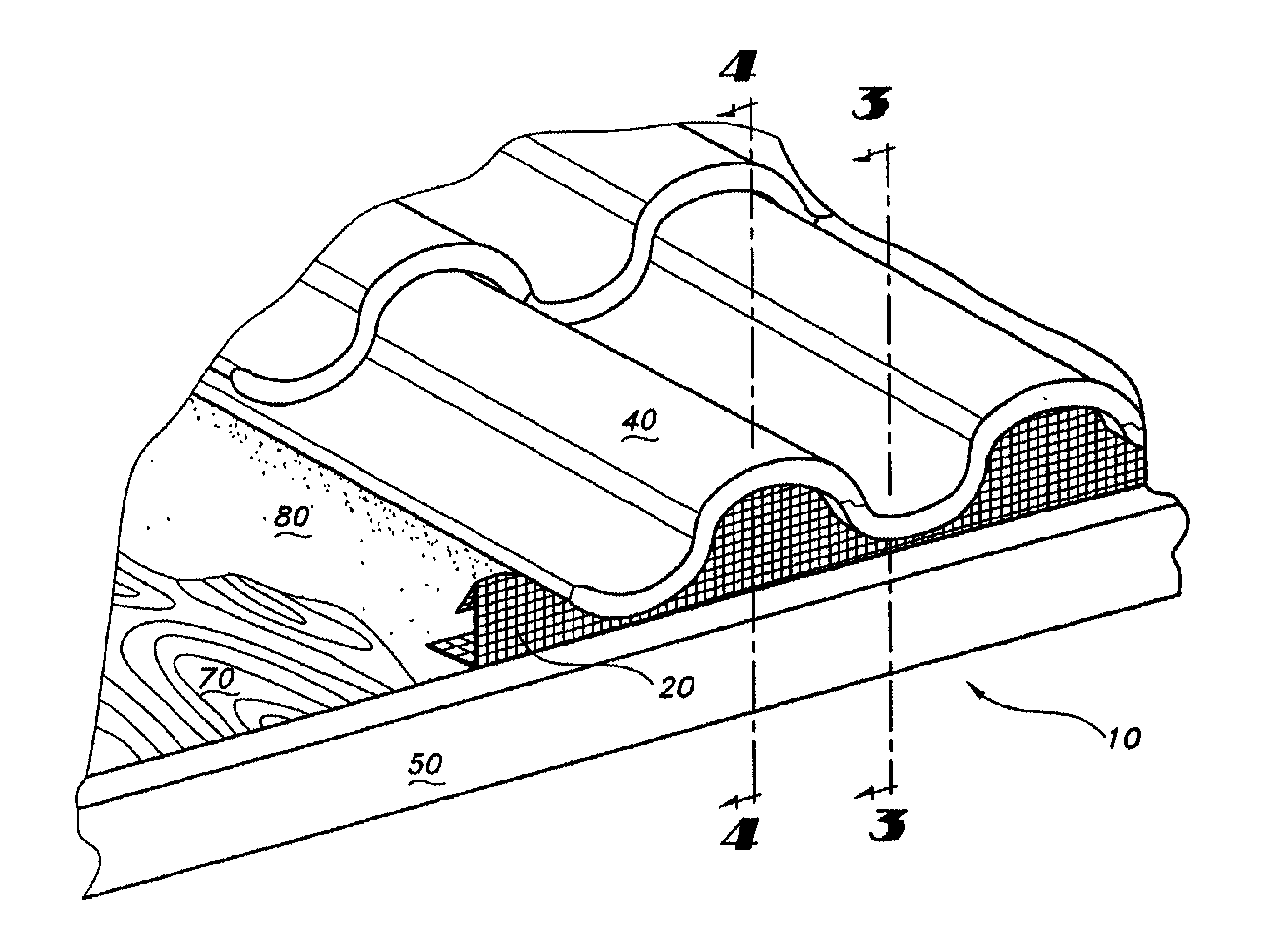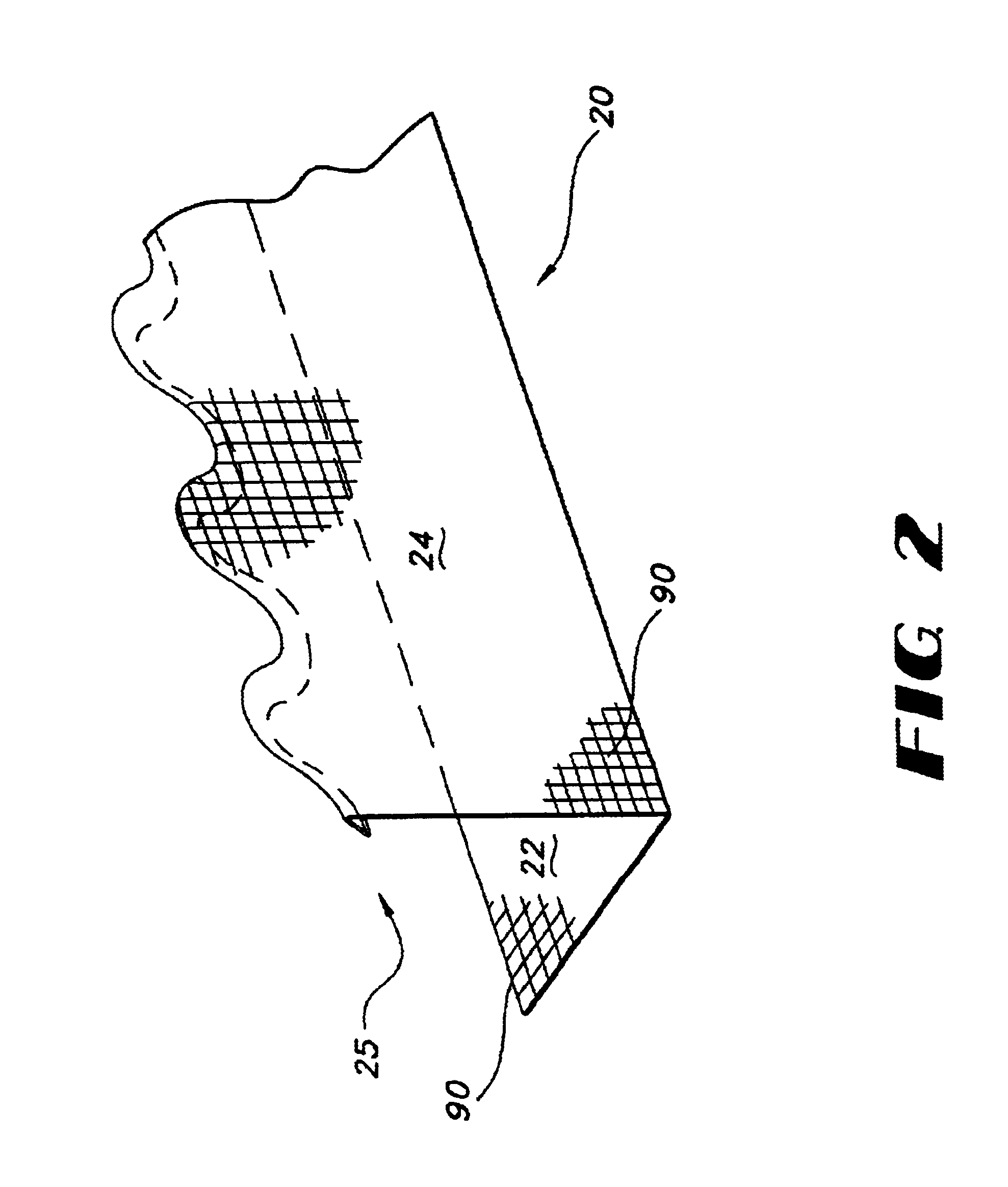Vented eaves closure
a technology of venting and eaves, which is applied in the field of roof tile installation, can solve the problems of increasing the complexity of technical challenges, and devices can create new problems, so as to facilitate the shedding of water, facilitate the circulation of air, and minimize heat transfer
- Summary
- Abstract
- Description
- Claims
- Application Information
AI Technical Summary
Benefits of technology
Problems solved by technology
Method used
Image
Examples
first embodiment
A First Embodiment
[0066]A first embodiment of the eaves closure system 10 of the present invention is shown in FIG. 1. A vented eaves closure 20 is supporting the first course of high-profile tiles 40 along the eaves 50 of a roof. The roof includes roof decking 70 and a waterproof underlayment 80.
[0067]FIG. 2 provides a more detailed perspective view of a vented eaves closure 20 according to the first embodiment. The vented eaves closure 20 includes a base 22 and a riser façade 24 disposed in planar contact with the base 22. The vented eaves closure 20 is preferably made from a single sheet of material having an array of openings 90. Preferably, the vented eaves closure 20 is made from a rigid or semi-rigid screen or meshed wire fabric to promote ventilation and allow drainage. The base 22 is placed generally parallel to the roof decking 70 and installed along the eaves 50 as shown in FIG. 1. The riser façade 24 extends vertically upward from the base 22 and has a sufficient height ...
second embodiment
A Second Embodiment
[0076]A second embodiment of the eaves closure system 10 of the present invention is shown in FIG. 5. In this embodiment, the eaves closure system 10 includes a vented eaves closure 20 and a vented profiled filler 30. The vented eaves closure 20, together with the vented profiled filler 30, supports the lower edge of the first course of roof tiles 40 and provides closure to the eaves 50.
[0077]In this embodiment, the vented eaves closure 20 has a uniform, standard shape that can be used to accept any of a variety of differently-contoured vented profiled fillers 30. As such, the vented eaves closure 20 shown in FIGS. 5 and 6 will have universal applicability among a wide variety of tile sizes and shapes. The vented eaves closure 20 will be suitable for use with any shape profiled filler 30. In fact, the vented eaves closure 20 may be used without a profiled filler 30 at all.
[0078]FIG. 12 demonstrates the usefulness of the vented eaves closure 20 of the second embodi...
third embodiment
A Third Embodiment
[0085]A third embodiment of the eaves closure system 10 of the present invention is shown in FIG. 9. A vented eaves closure 20 is supporting the first course of substantially-flat, low-profile tiles 45 along the eaves 50.
[0086]FIG. 10 provides a more detailed perspective view of a vented eaves closure 20 according to the third embodiment. The vented eaves closure 20 includes a base 22, a riser façade 24 disposed in planar contact with the base 22, and may include a rim 25 along the top edge of the riser façade 24. The vented eaves closure 20 is preferably made from a single sheet of material having an array of openings 90. Preferably, the vented eaves closure 20 is made from a rigid screen or meshed wire fabric to promote ventilation and allow drainage. The riser façade 24 extends vertically upward from the base 22 and has a sufficient height to support the first course of high-profile roof tiles 40 at a desired angle or pitch. The generally straight edge of the ri...
PUM
| Property | Measurement | Unit |
|---|---|---|
| area | aaaaa | aaaaa |
| size | aaaaa | aaaaa |
| sizes | aaaaa | aaaaa |
Abstract
Description
Claims
Application Information
 Login to View More
Login to View More - R&D
- Intellectual Property
- Life Sciences
- Materials
- Tech Scout
- Unparalleled Data Quality
- Higher Quality Content
- 60% Fewer Hallucinations
Browse by: Latest US Patents, China's latest patents, Technical Efficacy Thesaurus, Application Domain, Technology Topic, Popular Technical Reports.
© 2025 PatSnap. All rights reserved.Legal|Privacy policy|Modern Slavery Act Transparency Statement|Sitemap|About US| Contact US: help@patsnap.com



